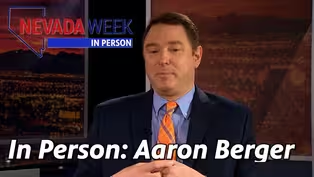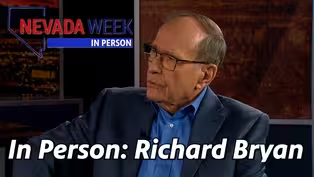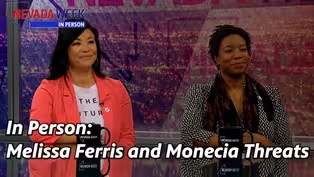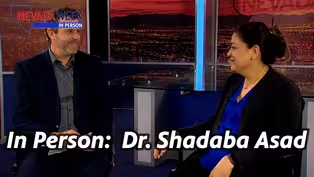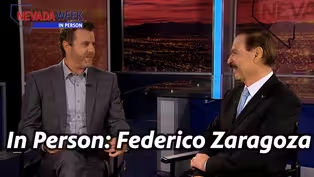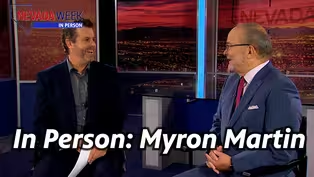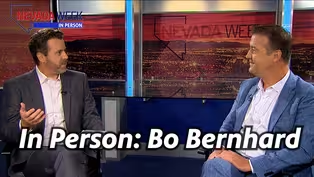
Nevada Week In Person | Jeff Scheid
Season 1 Episode 9 | 14mVideo has Closed Captions
A one-on-one interview with longtime Southern Nevada photojournalist Jeff Scheid.
We talk with longtime photojournalist Jeff Scheid about his life photographing Southern Nevada from news events to regular life.
Problems playing video? | Closed Captioning Feedback
Problems playing video? | Closed Captioning Feedback
Nevada Week In Person is a local public television program presented by Vegas PBS

Nevada Week In Person | Jeff Scheid
Season 1 Episode 9 | 14mVideo has Closed Captions
We talk with longtime photojournalist Jeff Scheid about his life photographing Southern Nevada from news events to regular life.
Problems playing video? | Closed Captioning Feedback
How to Watch Nevada Week In Person
Nevada Week In Person is available to stream on pbs.org and the free PBS App, available on iPhone, Apple TV, Android TV, Android smartphones, Amazon Fire TV, Amazon Fire Tablet, Roku, Samsung Smart TV, and Vizio.
Providing Support for PBS.org
Learn Moreabout PBS online sponsorshipMore from This Collection
Nevada Week In Person goes beyond the roundtable discussion of Nevada Week with guests for a more casual conversation about their personal passions, new projects and compelling stories that are overlooked in the flurry of the news cycle.
Nevada Week In Person | Aaron Berger
Video has Closed Captions
We talk with the executive director of the Neon Museum, Aaron Berger. (13m 59s)
Nevada Week In Person | Richard Bryan
Video has Closed Captions
Retired Nevada Senator Richard Bryan talks about his life in service of the state. (14m)
Nevada Week In Person | Monecia Threats and Melissa Ferris
Video has Closed Captions
Monecia Threats and Melissa Ferris talk sports in Las Vegas. (14m)
Nevada Week In Person | Brian ‘Paco’ Alvarez
Video has Closed Captions
A personal interview with arts and culture curator Brian ‘Paco’ Alvarez. (14m)
Nevada Week In Person | Dr. Shadaba Asad
Video has Closed Captions
Infectious disease expert Dr. Shadaba Asad on the coronavirus pandemic. (14m)
Nevada Week In Person | Federico Zaragoza
Video has Closed Captions
An in-depth and personal conversation with CSN President Federico Zaragoza. (14m)
Nevada Week In Person | Myron Martin
Video has Closed Captions
An in-depth personal discussion with Smith Center CEO Myron Martin. (14m)
Nevada Week In Person | Bo Bernhard
Video has Closed Captions
An in-depth conversation with Bo Bernhard from UNLV about his work with the university. (14m)
Providing Support for PBS.org
Learn Moreabout PBS online sponsorshipFrom Nevada's oldest cattle ranch to the streets of Las Vegas, photojournalist Jeff Scheid has photographed it all: Casino grand openings, street buskers, celebrations and defeats.
We talk to him about his career this week on Nevada Week In Person.
♪♪♪ Support for Nevada Week In Person is provided by Senator William H. Hernstadt and additional supporting sponsors.
(Kipp Ortenburger) Since the early 1980s, Jeff Scheid has turned the lens of his camera on Las Vegas and Nevada.
The high-level leaders and everyday workers have been featured in the photos he's taken first for the Las Vegas Review-Journal and now for the Nevada Independent.
In his own art, he has worked to bring the Silver State in all its variety to light.
Jeff, welcome.
This is really exciting.
-Thank you.
I appreciate it.
-I've been covering your work for a long time.
I know the name, I've never met you, so this is really exciting for me.
I wanted to come back-- you sent me your bio and I was reading through your bio, and you call yourself a "visual anthropologist."
Such an interesting term, and whenever we think-- we've had other anthropologists on the show before.
I always ask this question up front: Through your work, especially visual anthropology, what can you tell us about us as Las Vegans?
(Jeff Scheid) I think Nevada is such-- it's one of the most unique states in the union, and it just kind of-- we're still probably 50 years behind like California.
Imagine the Gold Rush of California and then Hollywood and everything expanded.
Vegas has the ranching and the mining that we had, and you build from there and now we have the greatest entertainment in Las Vegas, in the world.
I find Las Vegas and Nevada is just this really wonderful melting pot of old West meets new West and where we've gone.
I mean, little things like what happened to the movie theaters, drive-in movie theaters?
And especially like you go through the Mojave and you see these abandoned houses or buildings and businesses, and they had-- what kind of dream did they have at one time and where did that go?
I find going up in these rural communities and you look at, you know, maybe five buildings and at one time there was 5,000 people there.
You know, that's what's fascinating, and that's why I call myself a visual anthropologist because we discover who we are through history and finding out where we're going next.
-Yes.
I mean, going to a small town, a rural community and you find these buildings.
I mean, there's so much of a story there to tell.
You can't tell that story through photography necessarily because you don't delve into the history, but you can by what's represented then and I'm sure there is a way through photography to be able to tell that story in some manner.
Am I right on that?
-Yes.
I mean, I think it's-- what I like to do is there's a part of-- you go to some places in rural Nevada or throughout the West, and you're still living that lifestyle that people lived probably two, three, four generations before minus the four-wheel drive, minus the cell-- or plus the cell phone plus the four-wheel drive and, you know, broadband.
Now they're starting to get some broadband out there.
But basically we haven't really changed.
We're expanding, we're changing so much now that you have to capture that before it is lost, and especially when you look at Las Vegas too.
Who would have thought that, you know, the Sands would ever be imploded or the Riviera.
These were the great hotels from the '60s, '50s and '60s, and all the history there.
We just blow it up and then we kind of rebuild and start all over, and we kind of evolved as a state.
We have to do that too.
-Yes.
We're evolving, but it's interesting.
Now, you're going to have some of I think the best perspective of almost anybody in Las Vegas.
Being that I'm somewhat new to the area, "new" being six years now, there really is-- even though this is a big city-- this small-town feel where everybody knows everybody.
I mean, do you get that?
I mean, you know, the heads of state versus even, you know, the frontline workers in this case all are somewhat connected.
-I find this is-- my wife and I travel a lot around the world, and when they find out-- years ago when I'd say I'm from Las Vegas, and they'd say where's that at, and I'd finally say L.A. because they had no idea.
And then when the Travel Channel and cable TV and stuff like that, especially the Travel Channel when they started profiling Las Vegas, ooh, Las Vegas.
Gangsters, bang bang, whatever, you know.
But in saying that, I find it kind of exciting that my-- sorry, I lost my thought there.
But basically when I go there and I tell them that I know-- I've met all the governors in Nevada from 1955 on, you know, that's pretty fascinating.
My first person was Governor Russell and now all the way up to Governor Sisolak.
Nothing more wonderful than when you go-- and even now Governor Sandoval is now retired but I saw him at the opening of Resorts World, and he saw me 20 feet away and he waved at me.
You know, I've had other times Governor Sisolak, I had an issue with a certain Washington, D.C. PR person that was kind of giving me hassle, and I go, you know, I said Governor, how you doing?
The next thing you know, this guy never gave me crap the rest of the day.
You know, I like that.
I use the governor's card a lot when I'm traveling.
It never gives me comping privileges but at least they're like oh, you know the governor.
That could be good or bad depending on political viewpoint.
-And who you're talking to, and who you're trying to leverage, absolutely.
But you're right, we have access to heads of state like our governor like we've never had before.
I mean, I think it surprised a lot of people to see the governor driving his own car when that accident happened.
I think there might be a motorcade or something like that, and that's not really the reality.
And a lot of governors stepped in and said hey, I used to drive my own car too.
I mean, that's a normal thing, right?
-Yes.
I mean, I find like-- and I get to go up and start talking to them, and I think sometimes it doesn't matter if it's a governor or a political person or a celebrity or anybody.
You kind of get more relaxed around a photographer because you don't have the notebook, you don't have a phone sticking in front of them for a quote, and I've always gotten really good answers from them, and I find who they are because they're more relaxed and they're talking, and I find it's a way of photography too is to learn more about who this person is just by chatting with them.
-And to that point, I want to come to one of your recent works, Obsidian and Neon: Building Black Life and Identity in Las Vegas.
Very intimate black and white portraits and photos in this, and I want to come to what you just said about the governor.
You don't have a notebook necessarily, but you are representing people in a very intimate manner.
How easy is it to do that, to get them to-- you know, maybe there isn't any direction, but just to be able to build that connection you need with your subject to get the photo you want.
-With Obsidian and Neon, when we started working on that project with my partner, Erica Vital-Lazare, I sat in the interviews.
I wanted-- you know, I think the most important thing as photojournalists is to know your subject, and the best thing to do is sit in the interview and find out who they are and then afterwards talk about what they want to show their identity of for this portrait I'll shoot.
For example when Joe Neal-- and I remember Senator Neal from years ago.
In the '90s, I'd go up to the legislature and cover him, and I thought oh, there goes Senator Neal again talking.
But then, you know, flashing forward three years ago before he passed away, I went to his home and I said Senator, where do you want your picture taken?
He said right in front of this library of books.
And I said, have you read all these?
And he said absolutely, every one.
And it was such a diverse viewpoint of history, and I realized how far advanced what he was talking about back in the 1990s is what we're trying to do today on diversity.
I found him being-- I now look back, and I wish I could have spent more time with Senator Neal because he's just a fascinating gentlemen.
-Well, great segue into a question.
Maybe you've already answered it.
If there was anybody you could photograph present time that has some connection to Las Vegas or Nevada, doesn't necessarily have to live here, who would that be?
-This is one that I really wouldn't-- I've thought about this, and I don't think it'd be anybody in particular.
It would be buckaroos of Northern Nevada and Sunday church ladies in West Las Vegas.
-Wow, that's specific.
-Yes.
Wouldn't it be wonderful to get both of them together as a portrait?
Wouldn't that be fun?
Because what that is, that is Nevada right there in a nutshell.
But you know, I think I want to explore more the diversity, and I think the reason I'm saying that is kind of because this is who we are.
The buckaroos settled Nevada through ranching and the miners, but that's still alive up there.
They still have chuck wagons that they run the range up there.
They have sheepherders that are up in the mountains living.
-Yes.
It's true, and I mean when you talk about just in the Las Vegas Valley alone, I mean, you don't need to get that far out to see that.
You don't need to go to Northern Nevada to see that also.
It is just right there and yet so different, so diverse, so many polar opposites in culture and ethnicity and viewpoints and everything else.
-But they're still the same because when you really get right down to it, a plate of food that is served by, you know, it's some recipe that has been passed down through families, it could be the French Basque up in Central Nevada or it could be the Cuban or the Middle Eastern or Asian meals they're cooking in Chinatown and stuff.
You know, it's all in that.
I think you can learn-- in a conversation you learn so much about people sitting and talk to them in front of the kitchen table.
-Yes, it's true.
We're going to get to some short questions in just a second.
I just wanted to ask you really briefly too, the evolution of photography itself.
I mean, we've gone from film to digital, but now we've got social media as such a big aspect of it.
How does that affect how you take pictures?
Does it affect how you take pictures at all?
-You know, I think sometimes when I post a photo sometimes, and I'm not as active on social medias like I used to be, but there was an example of when President Trump came to the Venetian a couple of years ago and spoke, and Mr. Sheldon Adelson sat in the front row with a Trump yarmulke.
I shot the photo from the back side so it had Trump on the back.
And that night my wife and I are going out to dinner, and my phone died because I had so many people respond to that photo.
That image, I think that was the biggest image I ever had on social media, and was well over a million hits.
And when you realize that who we are in Las Vegas, in Nevada, that people want to know about this community, and especially in that degree.
-Okay.
Some short questions here, really quick.
Best place in Las Vegas you like to photograph; is there a special location?
-You know, I was thinking about this quite a bit.
I like going-- and sometimes I have to get in the mood for this-- but going down on Fremont Street on a Saturday night because you get the-- you know, because you get the buskers, you get the Canadian tourists down there, you get the families and that whole mishmash and mosh pit of just humanity all around in one.
It's fun.
-It's true.
It's such an interesting blend between old Las Vegas and new Las Vegas down there, too.
Great.
A true Las Vegas experience is-- maybe you just said it, maybe it's Fremont, maybe it's not.
-Yes, that is good, but I also like just walking the Strip and going to Chinatown.
I mean, I think that corridor there is one of the most amazing areas for food.
I'm kind of proud that we can brag about hey, we're just right up there with L.A. and San Francisco and New York.
-It's true.
Nevada's most important asset is... -Diversity.
-I could have guessed you were going to say that.
One word: What do we need more of here?
-Listening.
-One word: What do we need less of here?
-Screaming.
(laughter) -Somehow those are connected.
Next big thing in Las Vegas-- what's it going to be?
-One word?
-You can use a couple.
-I think we have to get a major museum that we can do, organically build from bottom up.
-Yes.
Jeff, it's a pleasure.
-Thank you.
-Absolute pleasure.
Well, you can see Jeff's work in the exhibit Obsidian and Neon: Building Black Life and Identity in Las Vegas at the Sahara West Library through March of 2022.
Catch Nevada Week this Sunday at 5:30 or anytime on vegaspbs.org.
Thanks for joining us.

- News and Public Affairs

Top journalists deliver compelling original analysis of the hour's headlines.

- News and Public Affairs

FRONTLINE is investigative journalism that questions, explains and changes our world.












Support for PBS provided by:
Nevada Week In Person is a local public television program presented by Vegas PBS
